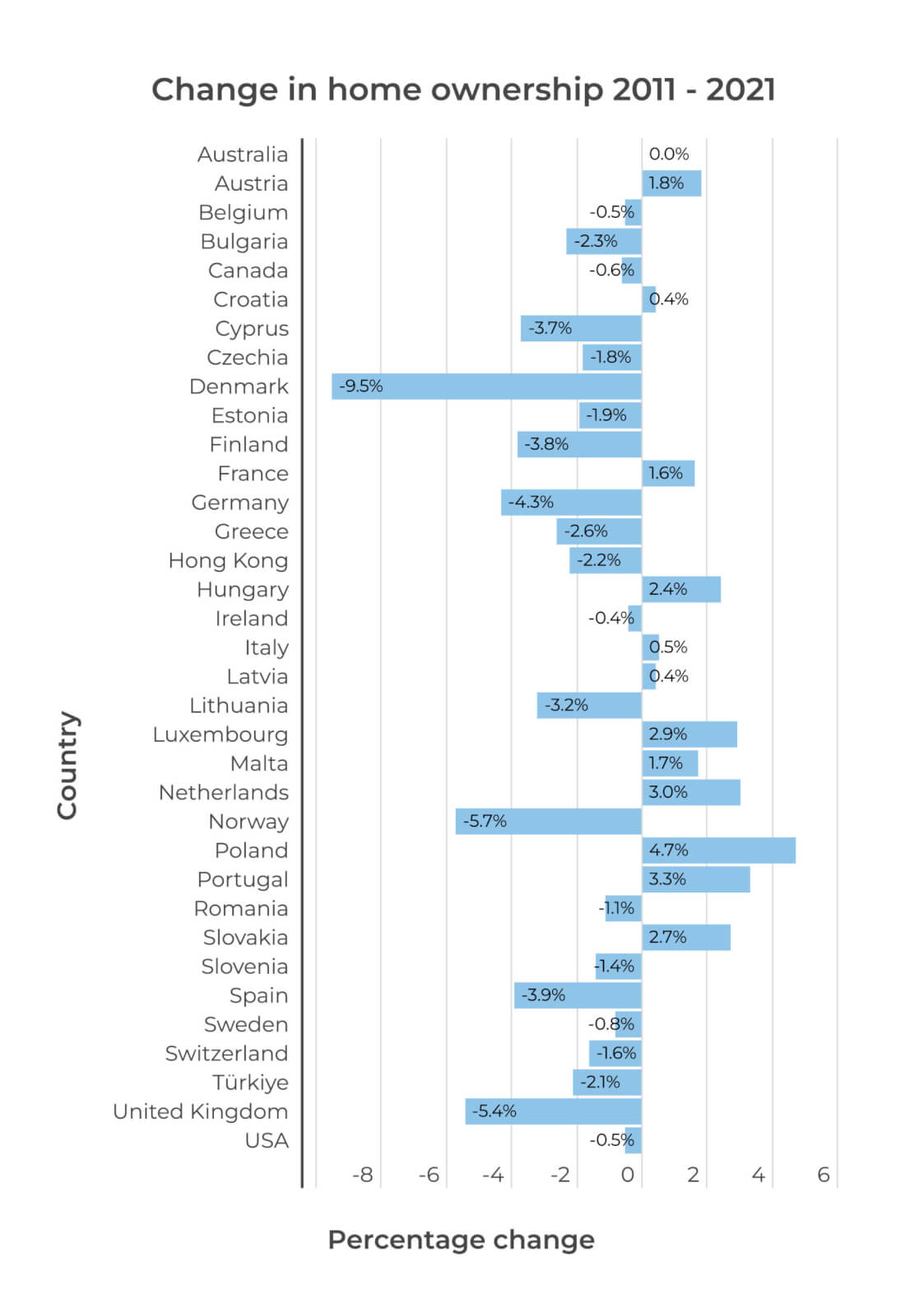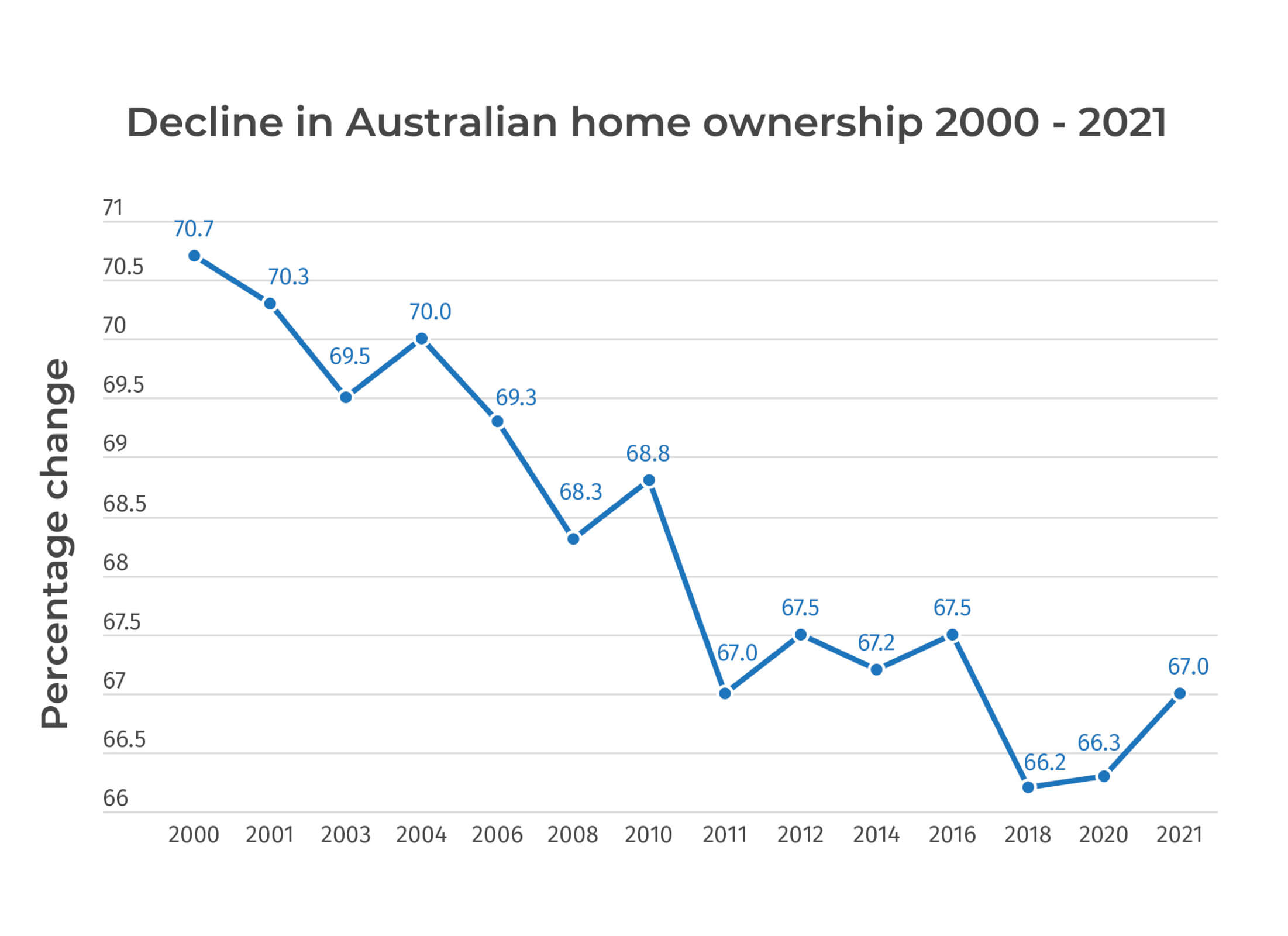The Burrow

Your home may be the most valuable asset you will ever own. Homes are valuable not just in a sentimental way, but also for the financial equity and appreciation in value.
But with house prices increasing around the world, are more people becoming home owners or less?
As home loan comparison and refinancing experts, we dived into the numbers for home ownership across the years over 35 countries globally. We compared figures up to 2021 (the latest available official data for several countries on the list) to see what has changed in the previous decade.
Let’s take a look at the results.
Out of the 35 countries we looked at, Poland had the biggest increase in the number of home owners at 4.7% from 2011 to 2021. Not only have Poland’s home ownership rates increased more than any other country, but it has one of the highest rates of home ownership out of all 35 countries we looked at.
In 2021, 86.8% of Poles owned their home, which was the sixth-highest out of all 35 nations. Romania had the highest proportion of home ownership at 95.3%, followed by Slovakia at 92.9% and Hungary at 91.7%.
Portugal had the second-highest increase of home ownership over the 10-year period at 3.3%, followed by the Netherlands at 3.0%. In 2021, 78.3% of Portuguese adults owned their own home, beating out their neighbour Spain which sat at 75.8%.
While some countries saw an increase in the percentage of the population that were home owners, about two-thirds of the 35 countries we looked at saw a decline or no growth (23 out of 35 nations).
Denmark had the biggest decrease, at 9.5%. This was followed by Norway with a 5.7% decrease, and the United Kingdom with a 5.4% drop in home ownership.
The table below shows the change in home ownership for each of the 35 countries from 2011 to 2021.
| Country | Change in home ownership 2011-2021 |
| Poland | +4.7% |
| Portugal | +3.3% |
| Netherlands | +3.0% |
| Luxembourg | +2.9% |
| Slovakia | +2.7% |
| Hungary | +2.4% |
| Austria | +1.8% |
| Malta | +1.7% |
| France | +1.6% |
| Italy | +0.5% |
| Croatia | +0.4% |
| Latvia | +0.4% |
| Australia | 0.0% |
| Ireland | -0.4% |
| Belgium | -0.5% |
| USA | -0.5% |
| Canada | -0.6% |
| Sweden | -0.8% |
| Romania | -1.1% |
| Slovenia | -1.4% |
| Switzerland | -1.6% |
| Czechia | -1.8% |
| Estonia | -1.9% |
| Türkiye | -2.1% |
| Hong Kong | -2.2% |
| Bulgaria | -2.3% |
| Greece | -2.6% |
| Lithuania | -3.2% |
| Cyprus | -3.7% |
| Finland | -3.8% |
| Spain | -3.9% |
| Germany | -4.3% |
| United Kingdom | -5.4% |
| Norway | -5.7% |
| Denmark | -9.5% |

In the chart above, there was no change from 2011 to 2021 for the percentage of Australians who owned a home, at 67.0%. This might make home ownership figures look steady, but if we go back further, home ownership in Australia is on a downwards trend.
Since the start of the 2000s, home ownership in Australia has been on a steady decline, picking up a little bit in 2021. In 2000, over 70% of Australians owned their home with a mortgage or outright, which dropped down to a low of 66.2% in 2018, before bouncing back to 67.0%.
The decline in Australians owning their own home is driven by housing affordability, and prices have risen well above wages and income, making it harder for new prospective buyers to get into the market at all.

Note: Some years had missing data and were not included in the line chart above.
To get a house of your own, you’ll likely need a home loan. Compare the Market’s General Manager of Money, Stephen Zeller, said comparing your home loan options could help you enter the property market and help you save money on your mortgage, helping you get off to a good start.
“By using a comparison service to weigh up your options, you can view available loans based on interest rates, comparison rates, fees and features,” Mr Zeller said.
“Finding a better interest rate could save you thousands over the course of your loan, depending on the size of your mortgage. Finding loans with less fees can also help you save money, while different features like redraw facilities or offset accounts can also help you manage your money over the life of your loan.
“Also, when you’ve found a loan you want to apply for, you can get guidance on your borrowing power, so you have confidence in knowing what your limit is when you start looking at houses for sale.”
Eligible Australian citizens and permanent residents can use Compare the Market to compare loans, as well as receive free monthly credit reports, as well as free property and suburb reports available any time. These can help borrowers get better prepared when it comes to buying a home.
We gathered data for 2011 and 2021 (the latest available data) for the number of home owners in each country. We then calculated the difference between 2011 and 2021 to identify the increase or decrease in home ownership as a proportion of the population.
Sources: